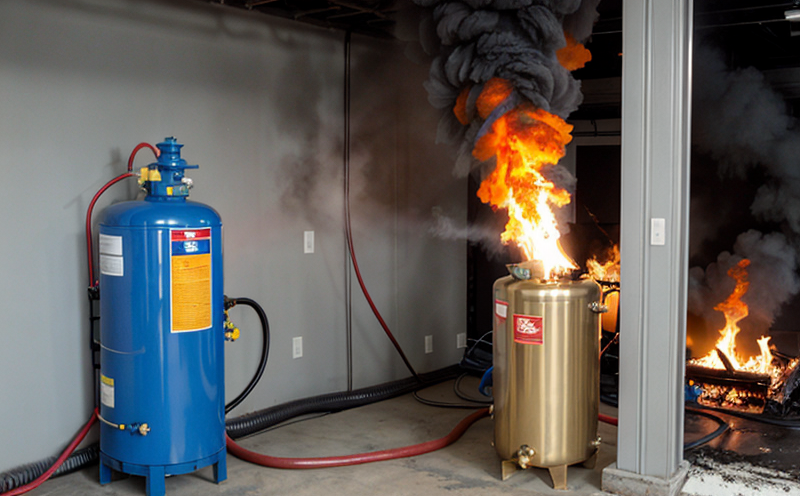NFPA 14 Standpipe and Hose Systems Testing
The NFPA 14 Standard on Standpipes and Hose Systems provides comprehensive guidelines aimed at ensuring that fire suppression systems are installed, maintained, and tested to provide effective protection against fires. This service focuses specifically on the testing of standpipe and hose systems in accordance with this standard.
Standpipe and hose systems are critical components of a building’s fire safety infrastructure. They serve as an immediate source of water for firefighting operations, which can be crucial in the initial stages of a fire. This service ensures that these systems meet stringent requirements set forth by NFPA 14 to guarantee their reliability during emergencies.
The testing process involves several key steps and considerations. First, it is essential to understand what constitutes a standpipe system according to NFPA 14. These systems typically consist of a fixed pipe network equipped with hose outlets, which are designed for fire fighting operations. The components must be regularly inspected and tested to ensure they function correctly.
Testing begins with a thorough inspection of the entire system, including the standpipes themselves, hose outlets, valves, and any other associated equipment. This inspection ensures that all parts are in good working condition and comply with NFPA 14 specifications. During this phase, we also verify that there is adequate pressure within the system to support firefighting operations.
Once the initial inspection is complete, actual testing can commence. This may include hydrant flow tests where water flows from fire hydrants at various points throughout the building or area being tested. These tests measure both the volume and velocity of water discharged by each outlet. It’s important to note that these measurements are critical because they determine whether enough water pressure is available for effective firefighting.
The testing process also includes checking the integrity of fire hose connections, ensuring they can withstand high-pressure bursts without leaking or failing. Additionally, we examine the condition of the fire hoses themselves, looking for signs of wear and tear that could compromise their effectiveness during use.
Another important aspect of NFPA 14 compliance is verifying that all necessary accessories are present and functioning properly. This includes items like nozzle adapters, safety chains, and other equipment required by the standard. Ensuring these components meet specifications helps maintain overall system integrity.
Throughout the testing process, we adhere strictly to the requirements outlined in NFPA 14. By doing so, we ensure that each component of the standpipe and hose system performs as expected under real-world conditions, thereby enhancing safety and preparedness for potential emergencies.
- Hydrant Flow Tests: Measure both volume and velocity of water discharged by fire hydrants.
- Hose Integrity Checks: Verify that hoses can withstand high-pressure bursts without leaking or failing.
- Accessory Verification: Ensure all necessary components are present and functioning properly according to NFPA 14 standards.
Scope and Methodology
The scope of our testing services for NFPA 14 standpipe and hose systems encompasses all aspects of the system as defined by the standard. This includes not only the physical components but also their installation, maintenance, and performance under various conditions.
Our methodology follows closely with the guidelines provided in NFPA 14 to ensure accuracy and consistency across tests conducted at different facilities or locations. We begin each project by thoroughly reviewing the existing documentation related to the standpipe system. This helps us identify any discrepancies between current practices and recommended standards, allowing for targeted improvements before testing begins.
During installation checks, we verify that all parts are correctly positioned according to NFPA 14 specifications. Proper positioning is crucial because even minor deviations can significantly impact performance during an actual emergency situation. Maintenance reviews focus on identifying potential issues such as corrosion or damage caused by exposure to harsh environmental factors over time.
Performance testing involves simulating real-world scenarios where the system would be called upon to deliver water for firefighting purposes. We use specialized equipment and techniques designed to replicate these conditions accurately, ensuring that every part of the system behaves predictably under stress.
Industry Applications
The application of NFPA 14 standpipe and hose systems testing is widespread across various industries where fire safety is paramount. Hospitals, schools, commercial buildings, and industrial plants all rely on these systems to ensure rapid response in case of a fire outbreak.
In hospitals, for instance, quick access to firefighting equipment can mean the difference between life and death during an emergency situation. Ensuring that standpipe systems are properly tested according to NFPA 14 standards helps maintain this critical capability. Similarly, schools and other educational institutions benefit from reliable fire suppression systems that protect both students and staff.
Commercial buildings also place significant importance on meeting these standards due to the high density of people within them. Industrial plants face additional challenges related to potential hazards posed by flammable materials or chemicals stored on site. In such cases, NFPA 14 compliance ensures not only basic fire safety but also protection against more severe risks.
Beyond just protecting lives and property, adherence to these standards contributes positively towards building reputations for reliability and trustworthiness among stakeholders. By demonstrating commitment to maintaining high-quality fire safety measures, organizations signal their dedication to operational excellence and public safety.





